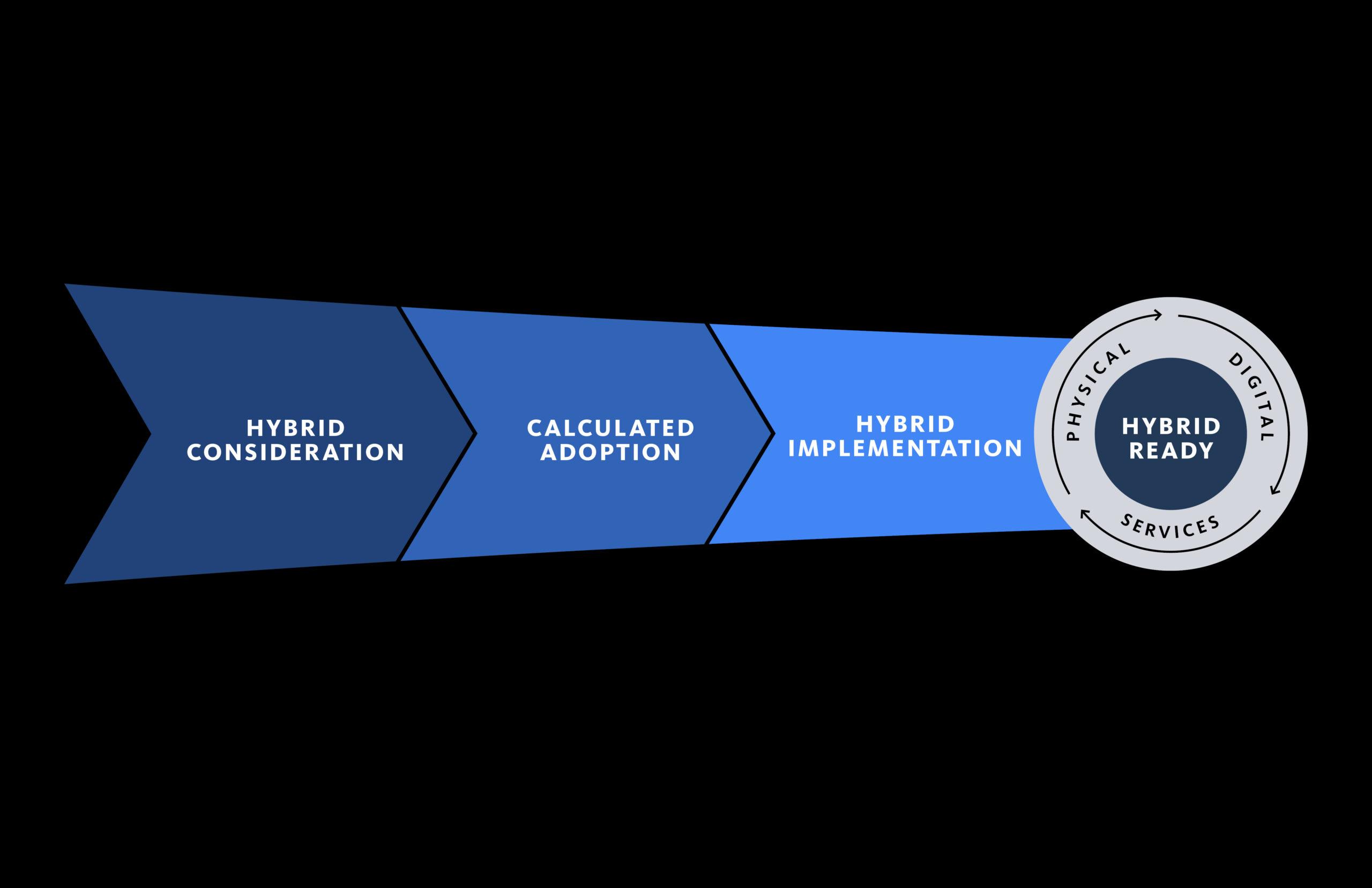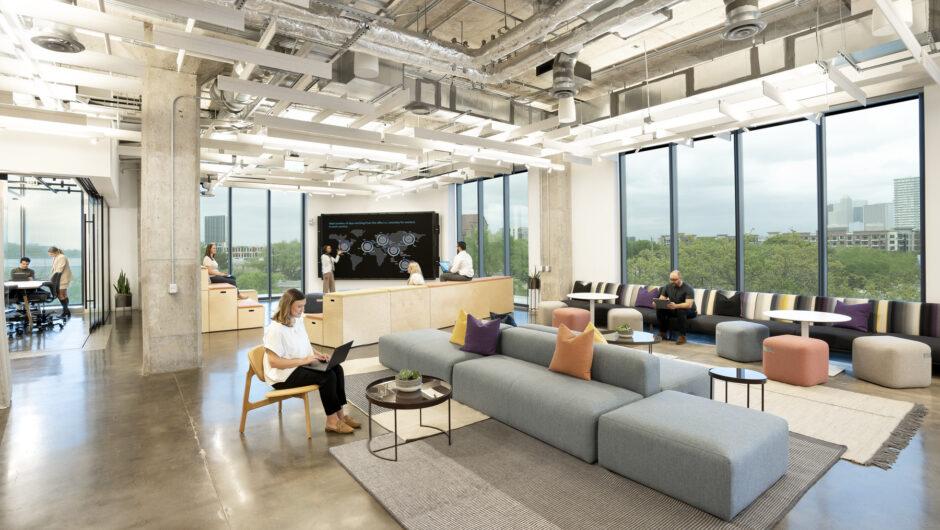The workplace is an ever-evolving space, but one thing is a constant: hybrid is here to stay. While this journey may be just beginning for some organizations, others have fully implemented hybrid work models. We spoke to a group of workplace strategy, real estate, and facilities leaders to learn about their different hybrid work models and understand how they have navigated the various stages of adoption, ensuring their key stakeholders’ success in the hybrid world.
Based on these conversations, we developed four stages of hybrid work adoption to ensure success of implementation and beyond as the workplace continues to evolve.
Create a Hybrid Adoption Plan with Wisp

Stage 1: Hybrid Consideration
The first stage in hybrid work adoption is “Hybrid Consideration.” Organization and business leaders drive this stage by trying to better understand implications around the idea that the future of work is hybrid. This exercise uncovers best case scenarios, worst case scenarios, and a deeper understanding of what success looks like for their organization. Many key stakeholders perform external research, develop policies, perform space management assessments, and inventory their technology and its capabilities.
As the deliberations for the transition to a hybrid workplace continues, understanding all considerations when returning to the office will be imperative. As Gensler’s Cindy Coleman and Don Ricker state in a recent blog, “there is no one-size-fits-all approach — outlining considerations, tools, and methodologies can help guide organizations facing the unprecedented challenges — and opportunities — of the workplace to create a better experience for all in the post-pandemic era.” Navigating the hybrid world is not only about change, methodologies, and space management but it’s also about better understanding an organization’s most valuable asset: their people. Organizations should conduct internal research to recognize and respond to the wants, needs, and amenities their teams are expecting.
While considering a hybrid work model, it’s also necessary for organizations to assess their space needs. Understanding the real estate portfolio, the space and its occupancy, the number of desks and workspaces needed, and a variety of space planning scenarios will help prepare an organization accelerate to the next stage in hybrid adoption.

Stage 2: Calculated Adoption
Once an organization has a deep understanding of their space and their employees’ expectations, it’s time to start creating new pilot spaces. During this stage of hybrid adoption, it’s important for organizations to think beyond status quo and think to the future of work and the amenities many people are looking for in the new workplace. Challenge the idea of what the workplace used to be and optimize the idea of what the workplace could be.
Pilot programs should be a top priority for all organizations, not only for changes in space and amenities, but also for policies, test metrics, assessments, and observations. Understanding space usage will be essential as teams start to engage additional leaders, such as human resources professionals, technology team members, and marketing experts. Once the proper key stakeholders have been outlined, it’s important to involve and integrate real estate teams. Preparing and communicating to key stakeholders with plans and next steps will help an organization move seamlessly from hybrid adoption to implementation.

Stage 3: Hybrid Implementation
Organizations across the world have been leveraging outside data, internal data, pilot programs, implementation data, and more. Stage three of the hybrid adoption journey will help organizations go beyond data gathering and piloting to actual implementation. Throughout this stage, organizations should be moving into their newly “designed” hybrid space and moving away from their traditional model.
This newly designed space does not have to be architecturally redesigned, but rather, it has been reimagined, piloted, and ready to undergo full implementation. Understanding both the organization’s and workers’ expectations for these reimagined spaces and creating a seamless process for execution can be critical to success. As leaders begin to implement their reimagined workplace, communicating these expectations will further assist adoption and developing a deeper understanding of the new workplace.
As the new hybrid workplace evolves, it’s imperative for businesses to embrace the change — to learn from each transformation and what it means for their organization and/or for their employees and occupants. Leaning into the change and challenges as they are presented will continue the forward trajectory of the hybrid workplace, as well as the organization.

Stage 4: Hybrid Ready and Beyond
After full implementation has occurred, the work is far from completed. As organizations move into the fourth and final stage of hybrid adoption, goals should shift to making existing space work harder, focusing more on the metrics, and leveraging learnings to continue to define the future of work. Taking a continuous look at the space — and understanding what’s working and what isn’t — will be extremely important as hybrid work continues to evolve.
To gain more insight, organizations should take a deeper look into various metrics to support the new hybrid workplace – including vacancies, occupancy ratios, and overall space efficiency. Utilizing these metrics is the best way to activate another one of an organization’s greatest assets — their space. Space and occupancy data can continue to support organizations with continued inventory measurement and a deeper understanding of the demand on space. Keeping a pulse on such data can also assist real estate and facilities teams with strategic planning and daily management. This will be imperative to ensure the success of the hybrid workplace.
As the hybrid workplace continues to evolve and shape the future of our offices, organizations should continue to learn and push the status quo of what hybrid is and what it will be long after hybrid implementation. This is not a time to return to old models, but rather, an opportunity to envision a new workplace — to rethink the purpose, mix of work activities and spaces, and the work experience to be more compelling and people-centric.
Create a Hybrid Adoption Plan with Wisp
For media inquiries, email media@gensler.com.


